United Parcel Service: Working and Leading People Report
VerifiedAdded on 2020/06/06
|17
|4655
|84
Report
AI Summary
This report delves into the core aspects of Human Resource Management (HRM) with a focus on working with and leading people. It begins by outlining the documentation required for the recruitment and selection of new employees, including job descriptions, person specifications, and the impact of legal, ethical, and regulatory considerations. The report then explores the skills and attributes essential for effective leadership, differentiating between leadership and management styles and comparing various leadership approaches for different situations. It further examines the benefits of team working and the importance of team dynamics in achieving organizational goals, including the assessment of team effectiveness. Finally, the report covers factors involved in planning, monitoring, and assessing work performance, including the assessment of individual development needs, concluding with an evaluation of the success of the assessment process. The report uses the United Parcel Service (UPS) as a case study, providing practical insights into HRM practices.
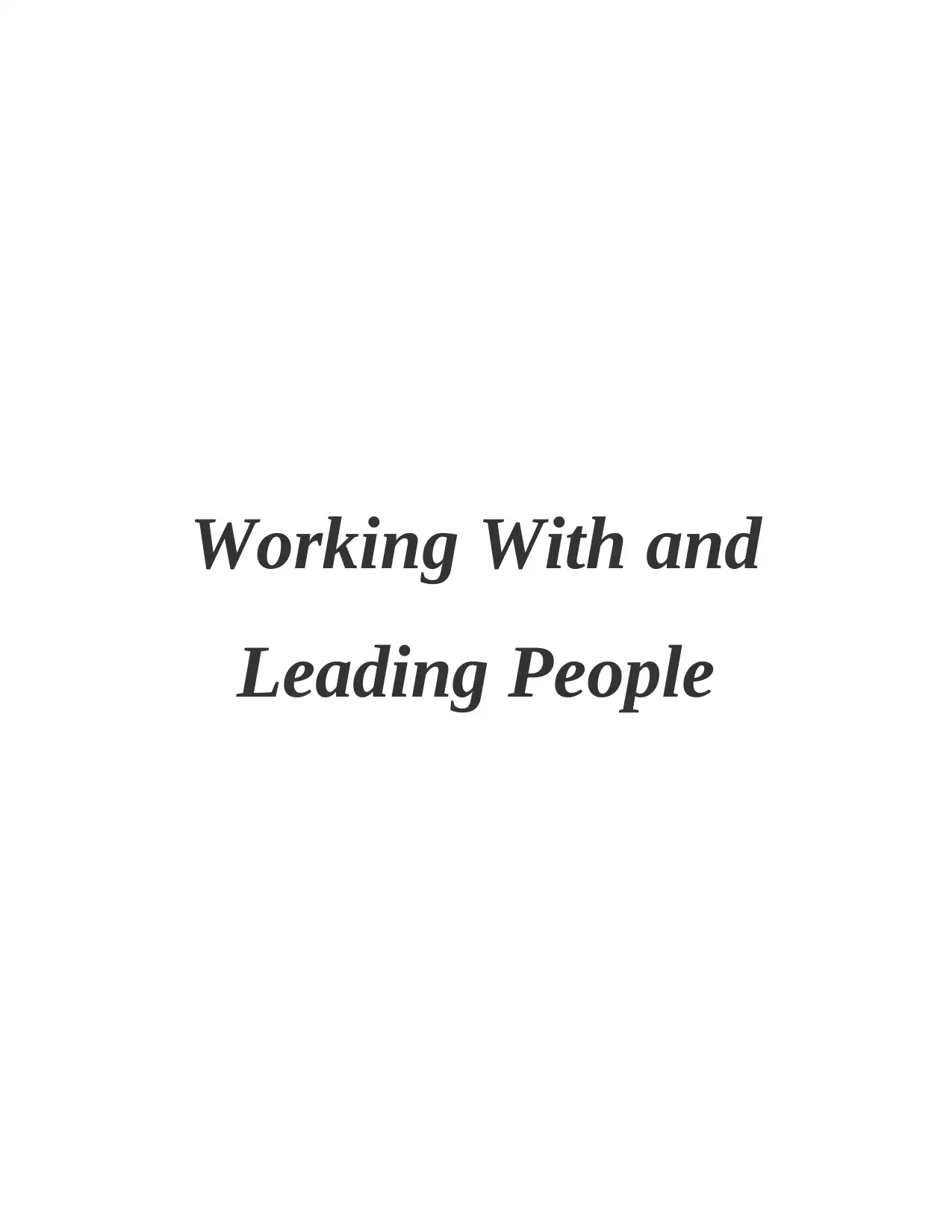
Working With and
Leading People
Leading People
Paraphrase This Document
Need a fresh take? Get an instant paraphrase of this document with our AI Paraphraser
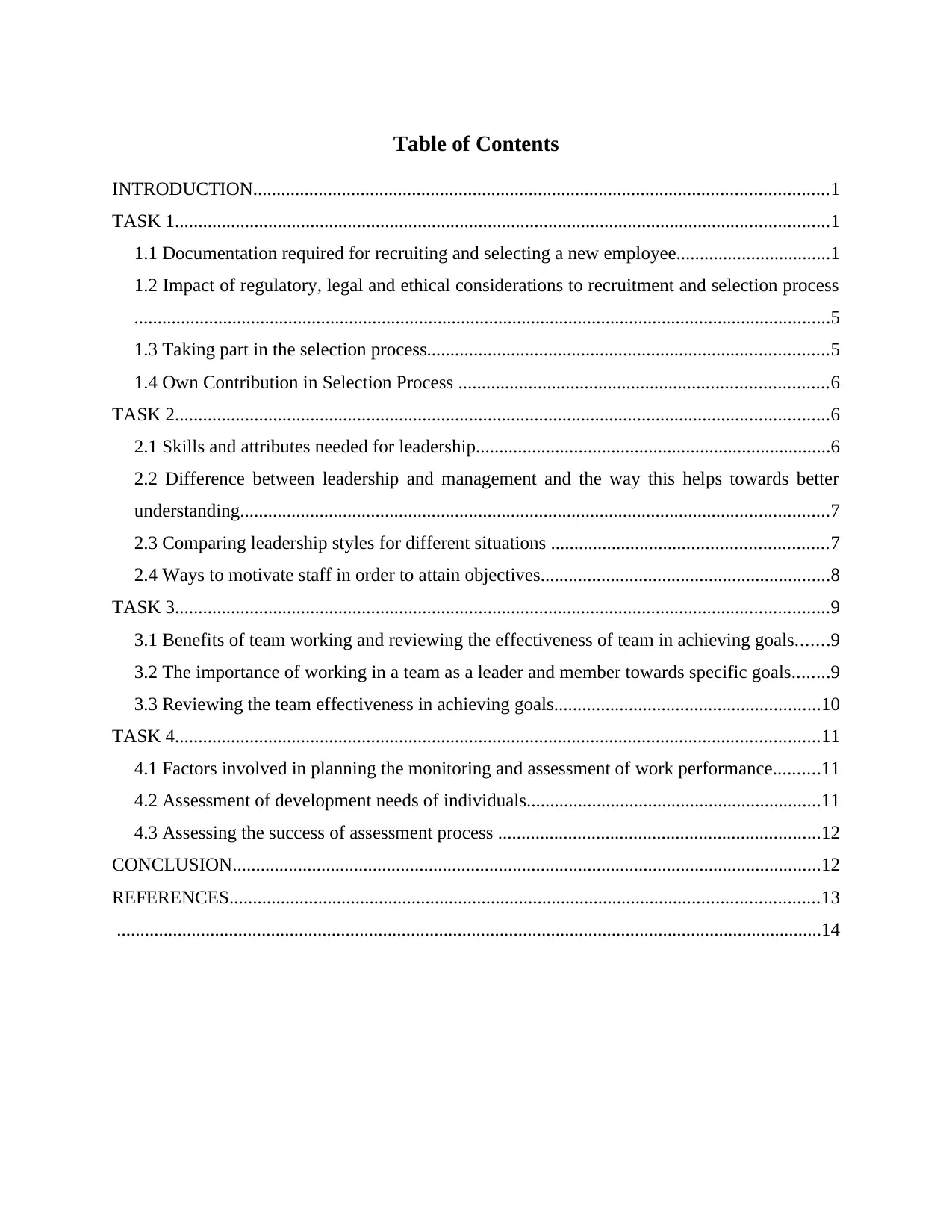
Table of Contents
INTRODUCTION...........................................................................................................................1
TASK 1............................................................................................................................................1
1.1 Documentation required for recruiting and selecting a new employee.................................1
1.2 Impact of regulatory, legal and ethical considerations to recruitment and selection process
.....................................................................................................................................................5
1.3 Taking part in the selection process......................................................................................5
1.4 Own Contribution in Selection Process ...............................................................................6
TASK 2............................................................................................................................................6
2.1 Skills and attributes needed for leadership............................................................................6
2.2 Difference between leadership and management and the way this helps towards better
understanding..............................................................................................................................7
2.3 Comparing leadership styles for different situations ...........................................................7
2.4 Ways to motivate staff in order to attain objectives..............................................................8
TASK 3............................................................................................................................................9
3.1 Benefits of team working and reviewing the effectiveness of team in achieving goals.......9
3.2 The importance of working in a team as a leader and member towards specific goals........9
3.3 Reviewing the team effectiveness in achieving goals.........................................................10
TASK 4..........................................................................................................................................11
4.1 Factors involved in planning the monitoring and assessment of work performance..........11
4.2 Assessment of development needs of individuals...............................................................11
4.3 Assessing the success of assessment process .....................................................................12
CONCLUSION..............................................................................................................................12
REFERENCES..............................................................................................................................13
.......................................................................................................................................................14
INTRODUCTION...........................................................................................................................1
TASK 1............................................................................................................................................1
1.1 Documentation required for recruiting and selecting a new employee.................................1
1.2 Impact of regulatory, legal and ethical considerations to recruitment and selection process
.....................................................................................................................................................5
1.3 Taking part in the selection process......................................................................................5
1.4 Own Contribution in Selection Process ...............................................................................6
TASK 2............................................................................................................................................6
2.1 Skills and attributes needed for leadership............................................................................6
2.2 Difference between leadership and management and the way this helps towards better
understanding..............................................................................................................................7
2.3 Comparing leadership styles for different situations ...........................................................7
2.4 Ways to motivate staff in order to attain objectives..............................................................8
TASK 3............................................................................................................................................9
3.1 Benefits of team working and reviewing the effectiveness of team in achieving goals.......9
3.2 The importance of working in a team as a leader and member towards specific goals........9
3.3 Reviewing the team effectiveness in achieving goals.........................................................10
TASK 4..........................................................................................................................................11
4.1 Factors involved in planning the monitoring and assessment of work performance..........11
4.2 Assessment of development needs of individuals...............................................................11
4.3 Assessing the success of assessment process .....................................................................12
CONCLUSION..............................................................................................................................12
REFERENCES..............................................................................................................................13
.......................................................................................................................................................14
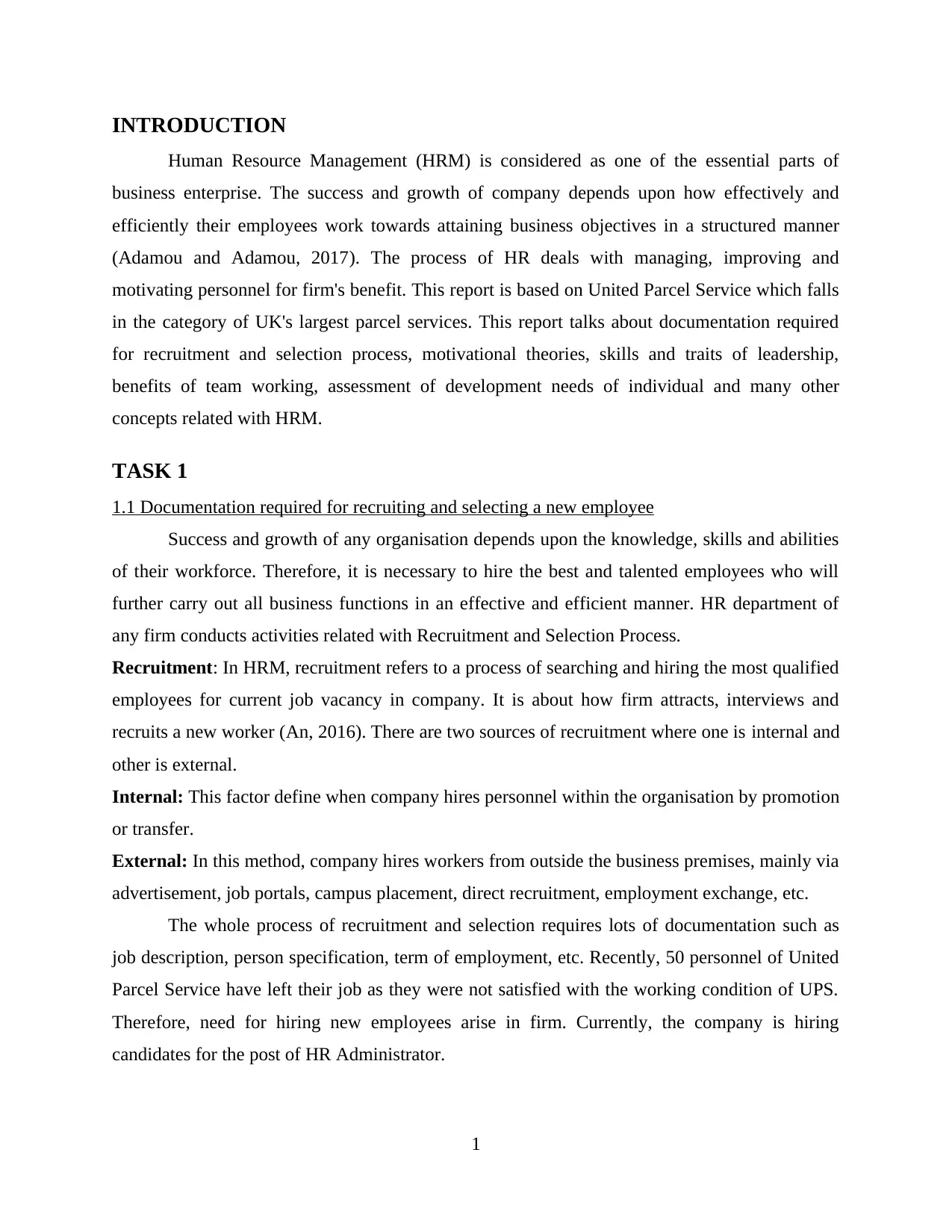
INTRODUCTION
Human Resource Management (HRM) is considered as one of the essential parts of
business enterprise. The success and growth of company depends upon how effectively and
efficiently their employees work towards attaining business objectives in a structured manner
(Adamou and Adamou, 2017). The process of HR deals with managing, improving and
motivating personnel for firm's benefit. This report is based on United Parcel Service which falls
in the category of UK's largest parcel services. This report talks about documentation required
for recruitment and selection process, motivational theories, skills and traits of leadership,
benefits of team working, assessment of development needs of individual and many other
concepts related with HRM.
TASK 1
1.1 Documentation required for recruiting and selecting a new employee
Success and growth of any organisation depends upon the knowledge, skills and abilities
of their workforce. Therefore, it is necessary to hire the best and talented employees who will
further carry out all business functions in an effective and efficient manner. HR department of
any firm conducts activities related with Recruitment and Selection Process.
Recruitment: In HRM, recruitment refers to a process of searching and hiring the most qualified
employees for current job vacancy in company. It is about how firm attracts, interviews and
recruits a new worker (An, 2016). There are two sources of recruitment where one is internal and
other is external.
Internal: This factor define when company hires personnel within the organisation by promotion
or transfer.
External: In this method, company hires workers from outside the business premises, mainly via
advertisement, job portals, campus placement, direct recruitment, employment exchange, etc.
The whole process of recruitment and selection requires lots of documentation such as
job description, person specification, term of employment, etc. Recently, 50 personnel of United
Parcel Service have left their job as they were not satisfied with the working condition of UPS.
Therefore, need for hiring new employees arise in firm. Currently, the company is hiring
candidates for the post of HR Administrator.
1
Human Resource Management (HRM) is considered as one of the essential parts of
business enterprise. The success and growth of company depends upon how effectively and
efficiently their employees work towards attaining business objectives in a structured manner
(Adamou and Adamou, 2017). The process of HR deals with managing, improving and
motivating personnel for firm's benefit. This report is based on United Parcel Service which falls
in the category of UK's largest parcel services. This report talks about documentation required
for recruitment and selection process, motivational theories, skills and traits of leadership,
benefits of team working, assessment of development needs of individual and many other
concepts related with HRM.
TASK 1
1.1 Documentation required for recruiting and selecting a new employee
Success and growth of any organisation depends upon the knowledge, skills and abilities
of their workforce. Therefore, it is necessary to hire the best and talented employees who will
further carry out all business functions in an effective and efficient manner. HR department of
any firm conducts activities related with Recruitment and Selection Process.
Recruitment: In HRM, recruitment refers to a process of searching and hiring the most qualified
employees for current job vacancy in company. It is about how firm attracts, interviews and
recruits a new worker (An, 2016). There are two sources of recruitment where one is internal and
other is external.
Internal: This factor define when company hires personnel within the organisation by promotion
or transfer.
External: In this method, company hires workers from outside the business premises, mainly via
advertisement, job portals, campus placement, direct recruitment, employment exchange, etc.
The whole process of recruitment and selection requires lots of documentation such as
job description, person specification, term of employment, etc. Recently, 50 personnel of United
Parcel Service have left their job as they were not satisfied with the working condition of UPS.
Therefore, need for hiring new employees arise in firm. Currently, the company is hiring
candidates for the post of HR Administrator.
1
⊘ This is a preview!⊘
Do you want full access?
Subscribe today to unlock all pages.

Trusted by 1+ million students worldwide
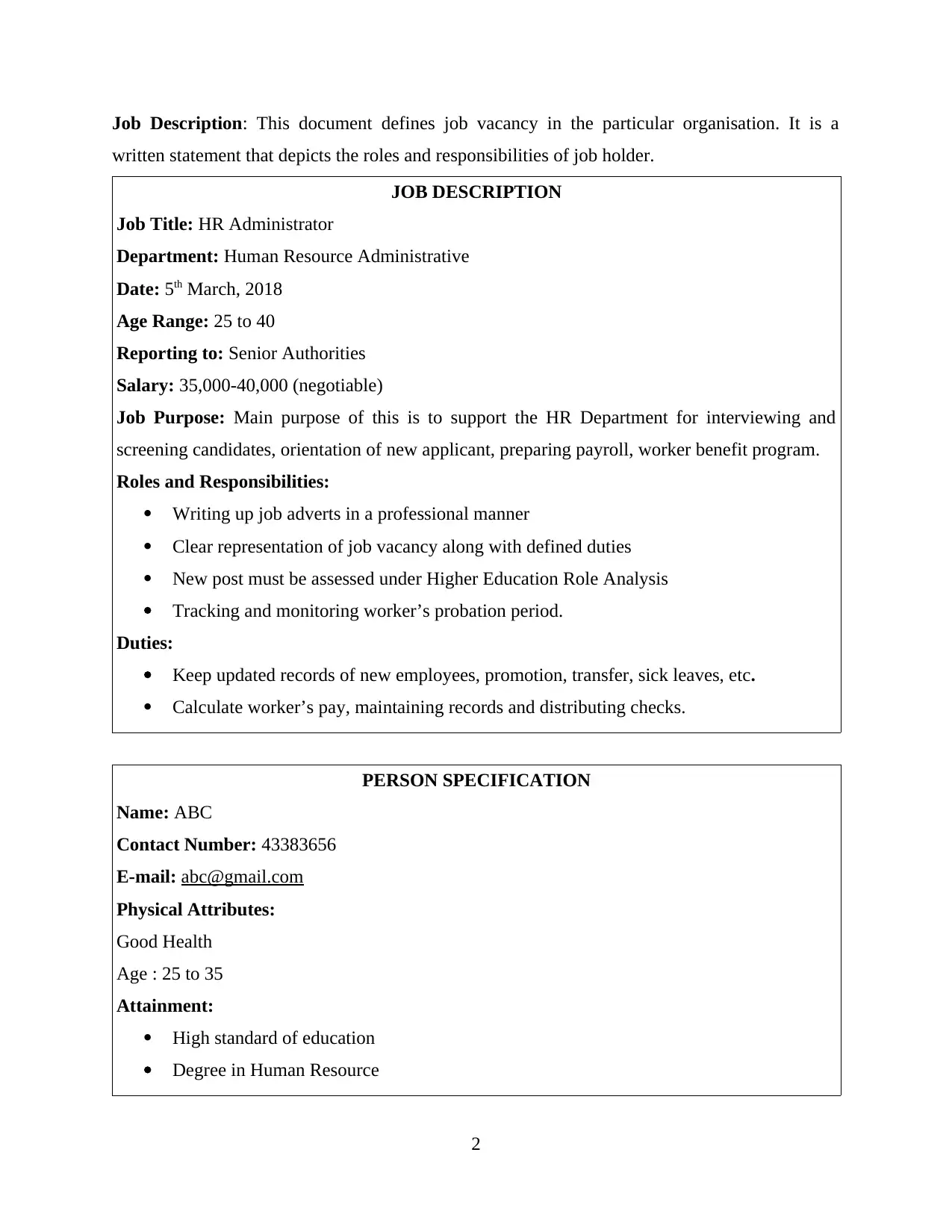
Job Description: This document defines job vacancy in the particular organisation. It is a
written statement that depicts the roles and responsibilities of job holder.
JOB DESCRIPTION
Job Title: HR Administrator
Department: Human Resource Administrative
Date: 5th March, 2018
Age Range: 25 to 40
Reporting to: Senior Authorities
Salary: 35,000-40,000 (negotiable)
Job Purpose: Main purpose of this is to support the HR Department for interviewing and
screening candidates, orientation of new applicant, preparing payroll, worker benefit program.
Roles and Responsibilities:
Writing up job adverts in a professional manner
Clear representation of job vacancy along with defined duties
New post must be assessed under Higher Education Role Analysis
Tracking and monitoring worker’s probation period.
Duties:
Keep updated records of new employees, promotion, transfer, sick leaves, etc.
Calculate worker’s pay, maintaining records and distributing checks.
PERSON SPECIFICATION
Name: ABC
Contact Number: 43383656
E-mail: abc@gmail.com
Physical Attributes:
Good Health
Age : 25 to 35
Attainment:
High standard of education
Degree in Human Resource
2
written statement that depicts the roles and responsibilities of job holder.
JOB DESCRIPTION
Job Title: HR Administrator
Department: Human Resource Administrative
Date: 5th March, 2018
Age Range: 25 to 40
Reporting to: Senior Authorities
Salary: 35,000-40,000 (negotiable)
Job Purpose: Main purpose of this is to support the HR Department for interviewing and
screening candidates, orientation of new applicant, preparing payroll, worker benefit program.
Roles and Responsibilities:
Writing up job adverts in a professional manner
Clear representation of job vacancy along with defined duties
New post must be assessed under Higher Education Role Analysis
Tracking and monitoring worker’s probation period.
Duties:
Keep updated records of new employees, promotion, transfer, sick leaves, etc.
Calculate worker’s pay, maintaining records and distributing checks.
PERSON SPECIFICATION
Name: ABC
Contact Number: 43383656
E-mail: abc@gmail.com
Physical Attributes:
Good Health
Age : 25 to 35
Attainment:
High standard of education
Degree in Human Resource
2
Paraphrase This Document
Need a fresh take? Get an instant paraphrase of this document with our AI Paraphraser
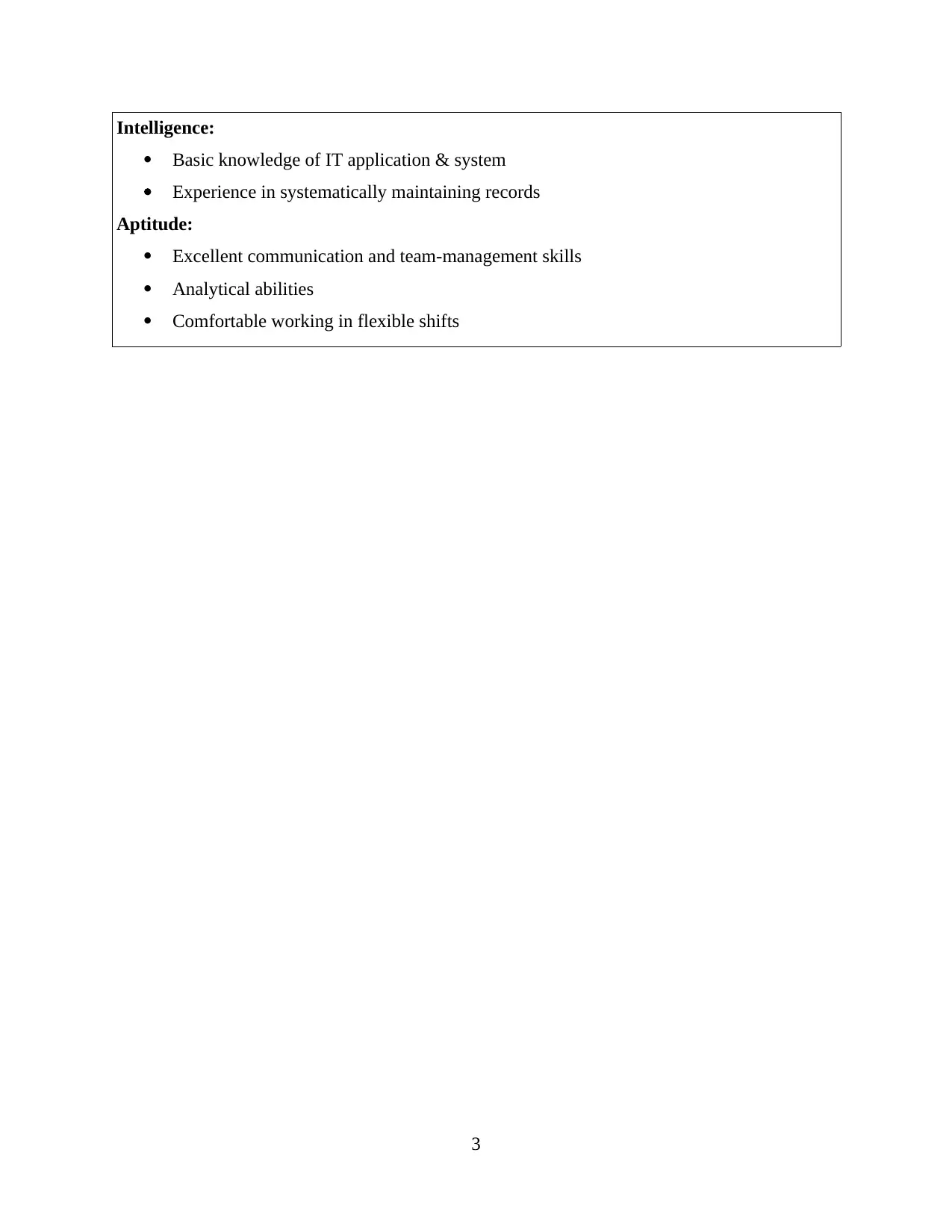
Intelligence:
Basic knowledge of IT application & system
Experience in systematically maintaining records
Aptitude:
Excellent communication and team-management skills
Analytical abilities
Comfortable working in flexible shifts
3
Basic knowledge of IT application & system
Experience in systematically maintaining records
Aptitude:
Excellent communication and team-management skills
Analytical abilities
Comfortable working in flexible shifts
3
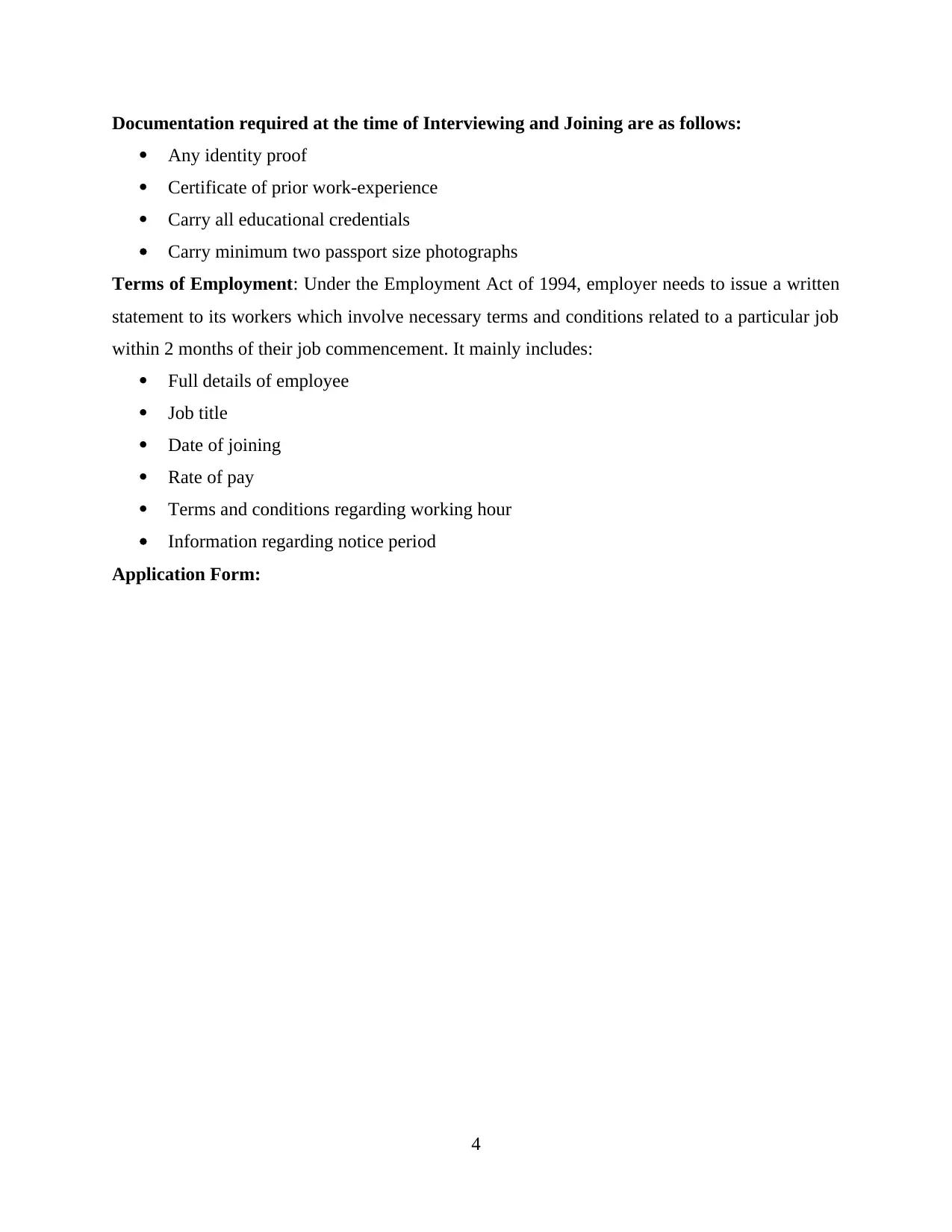
Documentation required at the time of Interviewing and Joining are as follows:
Any identity proof
Certificate of prior work-experience
Carry all educational credentials
Carry minimum two passport size photographs
Terms of Employment: Under the Employment Act of 1994, employer needs to issue a written
statement to its workers which involve necessary terms and conditions related to a particular job
within 2 months of their job commencement. It mainly includes:
Full details of employee
Job title
Date of joining
Rate of pay
Terms and conditions regarding working hour
Information regarding notice period
Application Form:
4
Any identity proof
Certificate of prior work-experience
Carry all educational credentials
Carry minimum two passport size photographs
Terms of Employment: Under the Employment Act of 1994, employer needs to issue a written
statement to its workers which involve necessary terms and conditions related to a particular job
within 2 months of their job commencement. It mainly includes:
Full details of employee
Job title
Date of joining
Rate of pay
Terms and conditions regarding working hour
Information regarding notice period
Application Form:
4
⊘ This is a preview!⊘
Do you want full access?
Subscribe today to unlock all pages.

Trusted by 1+ million students worldwide
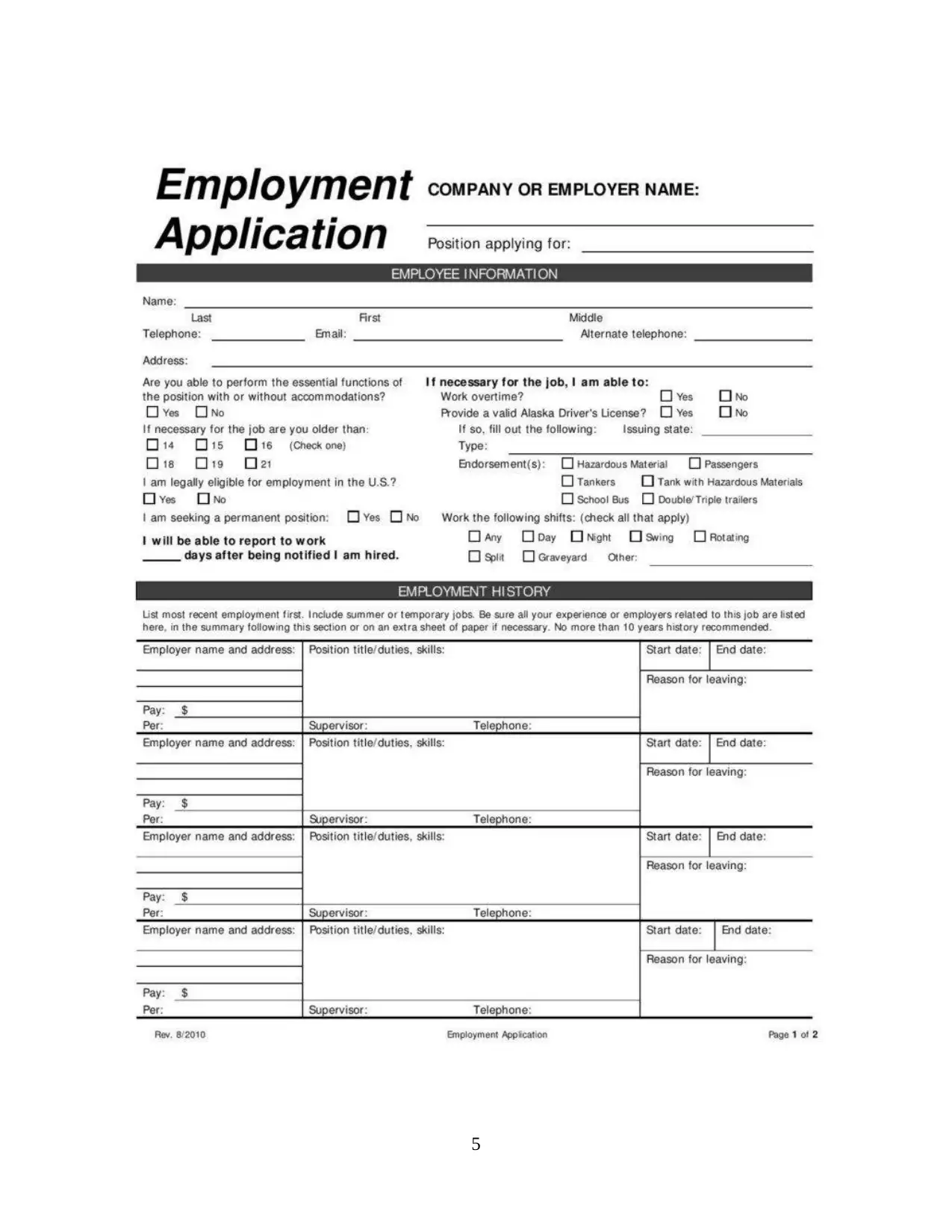
5
Paraphrase This Document
Need a fresh take? Get an instant paraphrase of this document with our AI Paraphraser
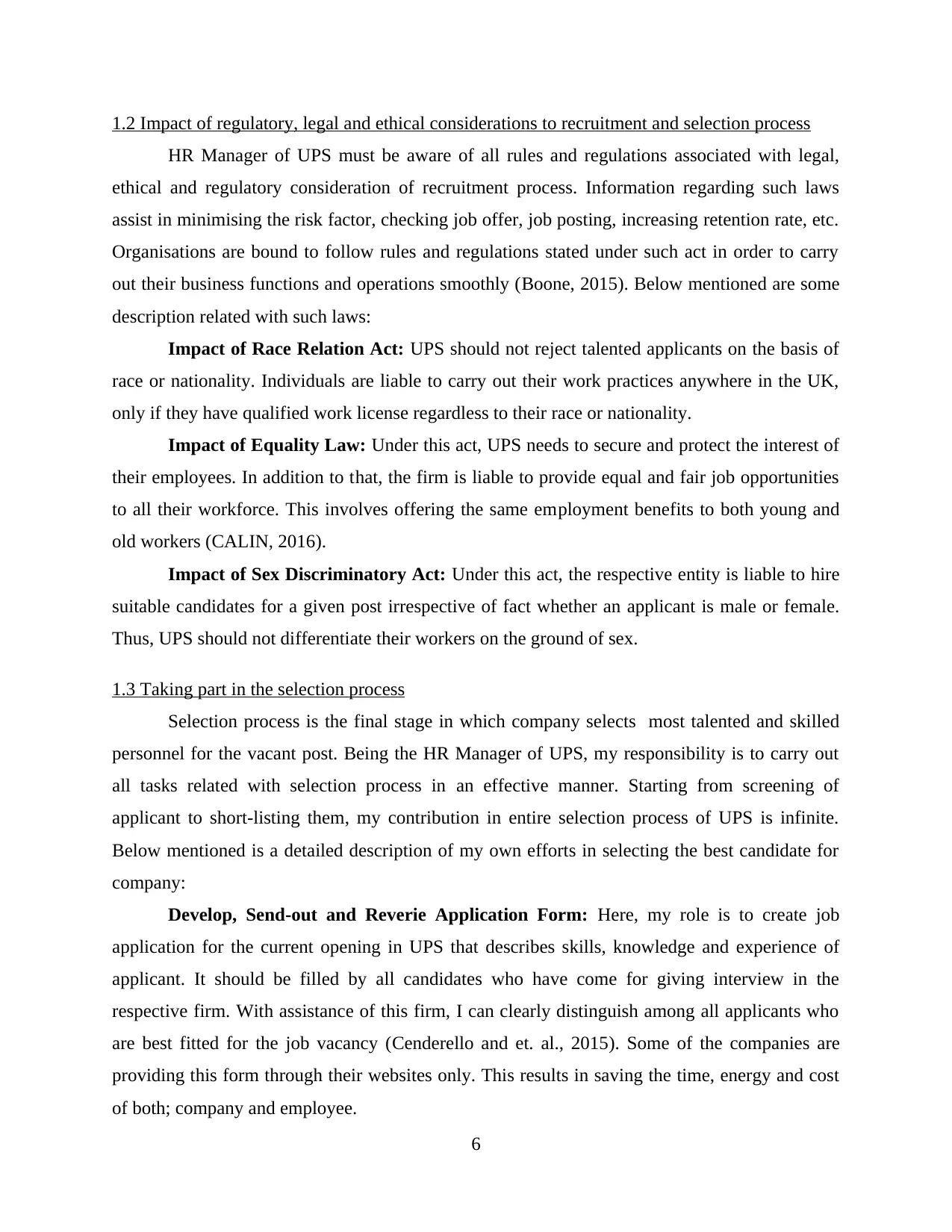
1.2 Impact of regulatory, legal and ethical considerations to recruitment and selection process
HR Manager of UPS must be aware of all rules and regulations associated with legal,
ethical and regulatory consideration of recruitment process. Information regarding such laws
assist in minimising the risk factor, checking job offer, job posting, increasing retention rate, etc.
Organisations are bound to follow rules and regulations stated under such act in order to carry
out their business functions and operations smoothly (Boone, 2015). Below mentioned are some
description related with such laws:
Impact of Race Relation Act: UPS should not reject talented applicants on the basis of
race or nationality. Individuals are liable to carry out their work practices anywhere in the UK,
only if they have qualified work license regardless to their race or nationality.
Impact of Equality Law: Under this act, UPS needs to secure and protect the interest of
their employees. In addition to that, the firm is liable to provide equal and fair job opportunities
to all their workforce. This involves offering the same employment benefits to both young and
old workers (CALIN, 2016).
Impact of Sex Discriminatory Act: Under this act, the respective entity is liable to hire
suitable candidates for a given post irrespective of fact whether an applicant is male or female.
Thus, UPS should not differentiate their workers on the ground of sex.
1.3 Taking part in the selection process
Selection process is the final stage in which company selects most talented and skilled
personnel for the vacant post. Being the HR Manager of UPS, my responsibility is to carry out
all tasks related with selection process in an effective manner. Starting from screening of
applicant to short-listing them, my contribution in entire selection process of UPS is infinite.
Below mentioned is a detailed description of my own efforts in selecting the best candidate for
company:
Develop, Send-out and Reverie Application Form: Here, my role is to create job
application for the current opening in UPS that describes skills, knowledge and experience of
applicant. It should be filled by all candidates who have come for giving interview in the
respective firm. With assistance of this firm, I can clearly distinguish among all applicants who
are best fitted for the job vacancy (Cenderello and et. al., 2015). Some of the companies are
providing this form through their websites only. This results in saving the time, energy and cost
of both; company and employee.
6
HR Manager of UPS must be aware of all rules and regulations associated with legal,
ethical and regulatory consideration of recruitment process. Information regarding such laws
assist in minimising the risk factor, checking job offer, job posting, increasing retention rate, etc.
Organisations are bound to follow rules and regulations stated under such act in order to carry
out their business functions and operations smoothly (Boone, 2015). Below mentioned are some
description related with such laws:
Impact of Race Relation Act: UPS should not reject talented applicants on the basis of
race or nationality. Individuals are liable to carry out their work practices anywhere in the UK,
only if they have qualified work license regardless to their race or nationality.
Impact of Equality Law: Under this act, UPS needs to secure and protect the interest of
their employees. In addition to that, the firm is liable to provide equal and fair job opportunities
to all their workforce. This involves offering the same employment benefits to both young and
old workers (CALIN, 2016).
Impact of Sex Discriminatory Act: Under this act, the respective entity is liable to hire
suitable candidates for a given post irrespective of fact whether an applicant is male or female.
Thus, UPS should not differentiate their workers on the ground of sex.
1.3 Taking part in the selection process
Selection process is the final stage in which company selects most talented and skilled
personnel for the vacant post. Being the HR Manager of UPS, my responsibility is to carry out
all tasks related with selection process in an effective manner. Starting from screening of
applicant to short-listing them, my contribution in entire selection process of UPS is infinite.
Below mentioned is a detailed description of my own efforts in selecting the best candidate for
company:
Develop, Send-out and Reverie Application Form: Here, my role is to create job
application for the current opening in UPS that describes skills, knowledge and experience of
applicant. It should be filled by all candidates who have come for giving interview in the
respective firm. With assistance of this firm, I can clearly distinguish among all applicants who
are best fitted for the job vacancy (Cenderello and et. al., 2015). Some of the companies are
providing this form through their websites only. This results in saving the time, energy and cost
of both; company and employee.
6
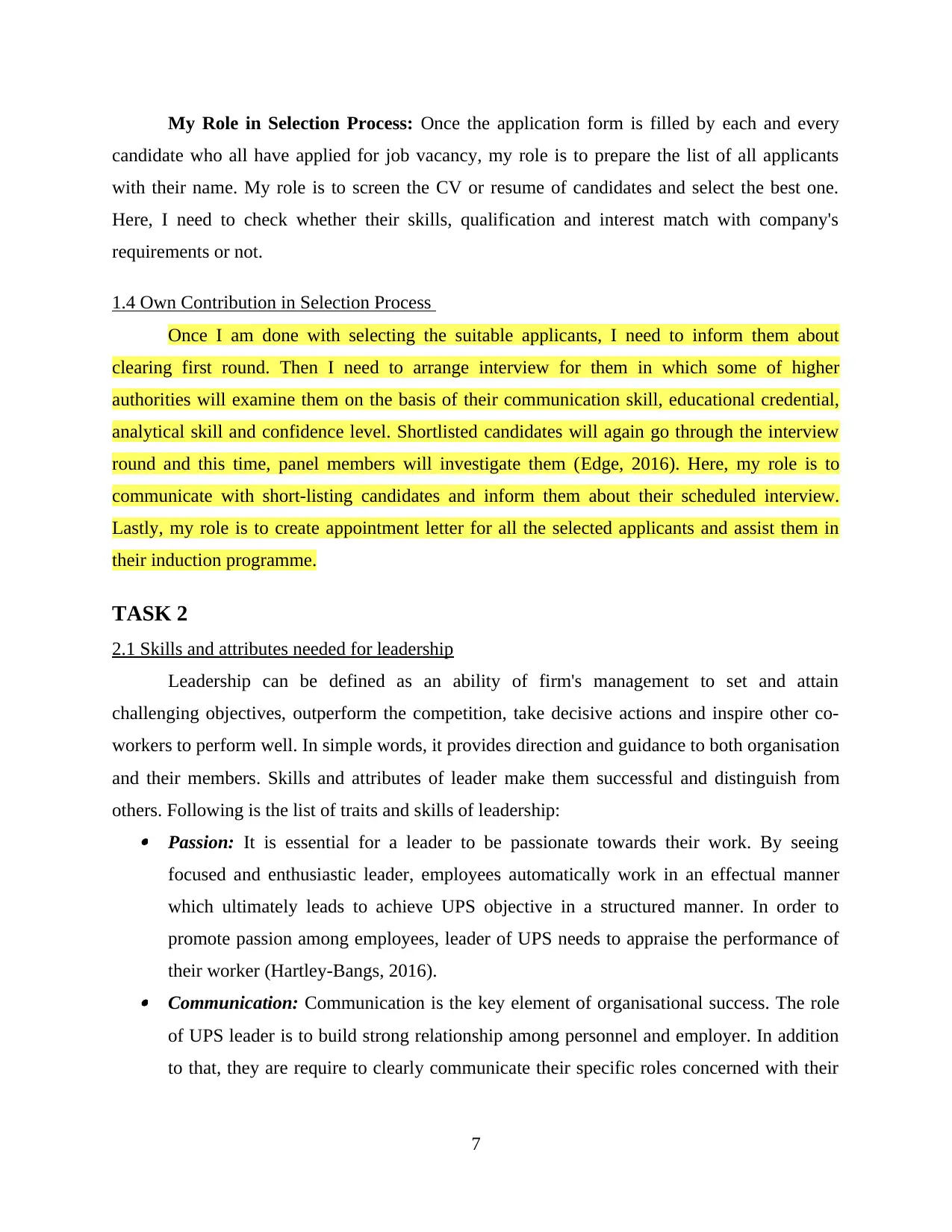
My Role in Selection Process: Once the application form is filled by each and every
candidate who all have applied for job vacancy, my role is to prepare the list of all applicants
with their name. My role is to screen the CV or resume of candidates and select the best one.
Here, I need to check whether their skills, qualification and interest match with company's
requirements or not.
1.4 Own Contribution in Selection Process
Once I am done with selecting the suitable applicants, I need to inform them about
clearing first round. Then I need to arrange interview for them in which some of higher
authorities will examine them on the basis of their communication skill, educational credential,
analytical skill and confidence level. Shortlisted candidates will again go through the interview
round and this time, panel members will investigate them (Edge, 2016). Here, my role is to
communicate with short-listing candidates and inform them about their scheduled interview.
Lastly, my role is to create appointment letter for all the selected applicants and assist them in
their induction programme.
TASK 2
2.1 Skills and attributes needed for leadership
Leadership can be defined as an ability of firm's management to set and attain
challenging objectives, outperform the competition, take decisive actions and inspire other co-
workers to perform well. In simple words, it provides direction and guidance to both organisation
and their members. Skills and attributes of leader make them successful and distinguish from
others. Following is the list of traits and skills of leadership: Passion: It is essential for a leader to be passionate towards their work. By seeing
focused and enthusiastic leader, employees automatically work in an effectual manner
which ultimately leads to achieve UPS objective in a structured manner. In order to
promote passion among employees, leader of UPS needs to appraise the performance of
their worker (Hartley-Bangs, 2016). Communication: Communication is the key element of organisational success. The role
of UPS leader is to build strong relationship among personnel and employer. In addition
to that, they are require to clearly communicate their specific roles concerned with their
7
candidate who all have applied for job vacancy, my role is to prepare the list of all applicants
with their name. My role is to screen the CV or resume of candidates and select the best one.
Here, I need to check whether their skills, qualification and interest match with company's
requirements or not.
1.4 Own Contribution in Selection Process
Once I am done with selecting the suitable applicants, I need to inform them about
clearing first round. Then I need to arrange interview for them in which some of higher
authorities will examine them on the basis of their communication skill, educational credential,
analytical skill and confidence level. Shortlisted candidates will again go through the interview
round and this time, panel members will investigate them (Edge, 2016). Here, my role is to
communicate with short-listing candidates and inform them about their scheduled interview.
Lastly, my role is to create appointment letter for all the selected applicants and assist them in
their induction programme.
TASK 2
2.1 Skills and attributes needed for leadership
Leadership can be defined as an ability of firm's management to set and attain
challenging objectives, outperform the competition, take decisive actions and inspire other co-
workers to perform well. In simple words, it provides direction and guidance to both organisation
and their members. Skills and attributes of leader make them successful and distinguish from
others. Following is the list of traits and skills of leadership: Passion: It is essential for a leader to be passionate towards their work. By seeing
focused and enthusiastic leader, employees automatically work in an effectual manner
which ultimately leads to achieve UPS objective in a structured manner. In order to
promote passion among employees, leader of UPS needs to appraise the performance of
their worker (Hartley-Bangs, 2016). Communication: Communication is the key element of organisational success. The role
of UPS leader is to build strong relationship among personnel and employer. In addition
to that, they are require to clearly communicate their specific roles concerned with their
7
⊘ This is a preview!⊘
Do you want full access?
Subscribe today to unlock all pages.

Trusted by 1+ million students worldwide
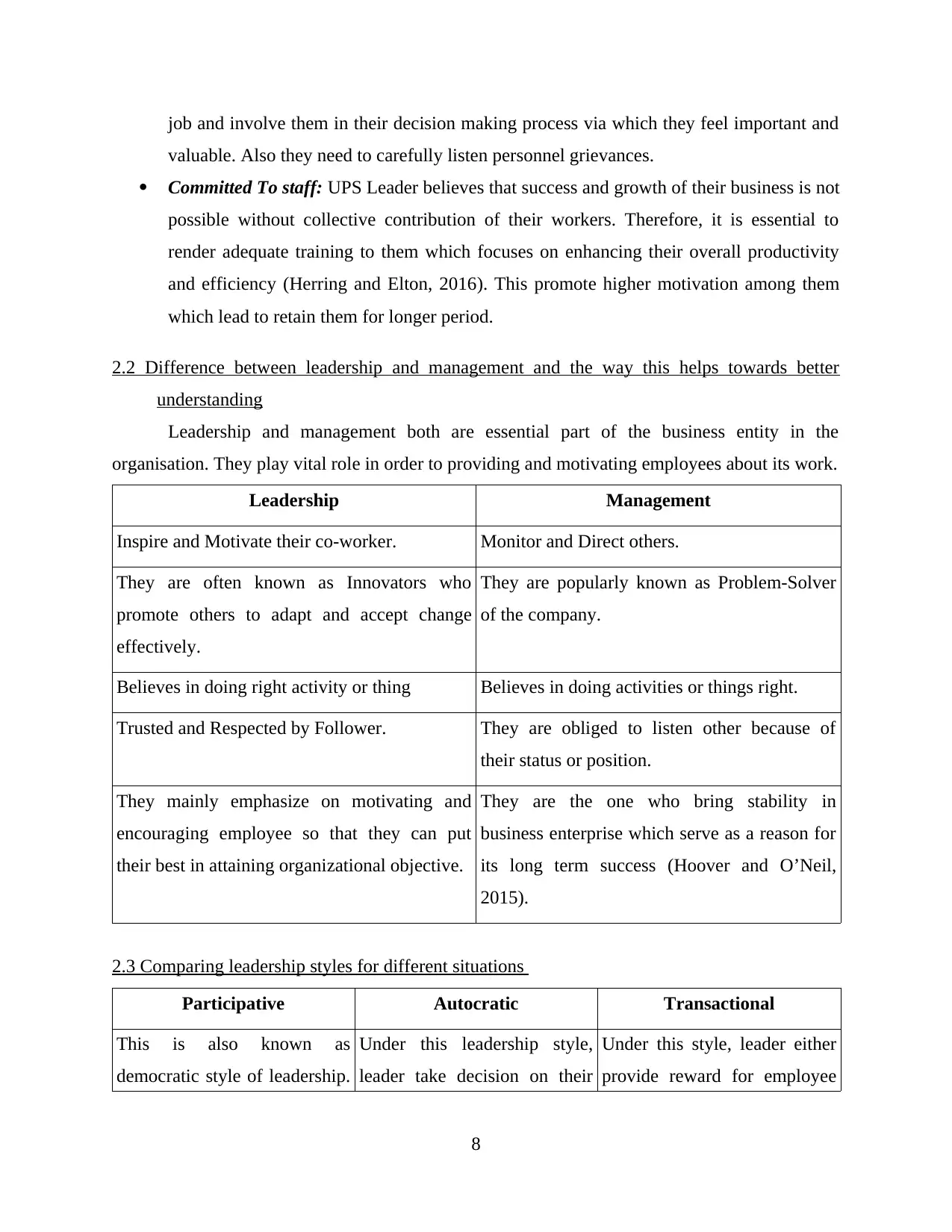
job and involve them in their decision making process via which they feel important and
valuable. Also they need to carefully listen personnel grievances.
Committed To staff: UPS Leader believes that success and growth of their business is not
possible without collective contribution of their workers. Therefore, it is essential to
render adequate training to them which focuses on enhancing their overall productivity
and efficiency (Herring and Elton, 2016). This promote higher motivation among them
which lead to retain them for longer period.
2.2 Difference between leadership and management and the way this helps towards better
understanding
Leadership and management both are essential part of the business entity in the
organisation. They play vital role in order to providing and motivating employees about its work.
Leadership Management
Inspire and Motivate their co-worker. Monitor and Direct others.
They are often known as Innovators who
promote others to adapt and accept change
effectively.
They are popularly known as Problem-Solver
of the company.
Believes in doing right activity or thing Believes in doing activities or things right.
Trusted and Respected by Follower. They are obliged to listen other because of
their status or position.
They mainly emphasize on motivating and
encouraging employee so that they can put
their best in attaining organizational objective.
They are the one who bring stability in
business enterprise which serve as a reason for
its long term success (Hoover and O’Neil,
2015).
2.3 Comparing leadership styles for different situations
Participative Autocratic Transactional
This is also known as
democratic style of leadership.
Under this leadership style,
leader take decision on their
Under this style, leader either
provide reward for employee
8
valuable. Also they need to carefully listen personnel grievances.
Committed To staff: UPS Leader believes that success and growth of their business is not
possible without collective contribution of their workers. Therefore, it is essential to
render adequate training to them which focuses on enhancing their overall productivity
and efficiency (Herring and Elton, 2016). This promote higher motivation among them
which lead to retain them for longer period.
2.2 Difference between leadership and management and the way this helps towards better
understanding
Leadership and management both are essential part of the business entity in the
organisation. They play vital role in order to providing and motivating employees about its work.
Leadership Management
Inspire and Motivate their co-worker. Monitor and Direct others.
They are often known as Innovators who
promote others to adapt and accept change
effectively.
They are popularly known as Problem-Solver
of the company.
Believes in doing right activity or thing Believes in doing activities or things right.
Trusted and Respected by Follower. They are obliged to listen other because of
their status or position.
They mainly emphasize on motivating and
encouraging employee so that they can put
their best in attaining organizational objective.
They are the one who bring stability in
business enterprise which serve as a reason for
its long term success (Hoover and O’Neil,
2015).
2.3 Comparing leadership styles for different situations
Participative Autocratic Transactional
This is also known as
democratic style of leadership.
Under this leadership style,
leader take decision on their
Under this style, leader either
provide reward for employee
8
Paraphrase This Document
Need a fresh take? Get an instant paraphrase of this document with our AI Paraphraser
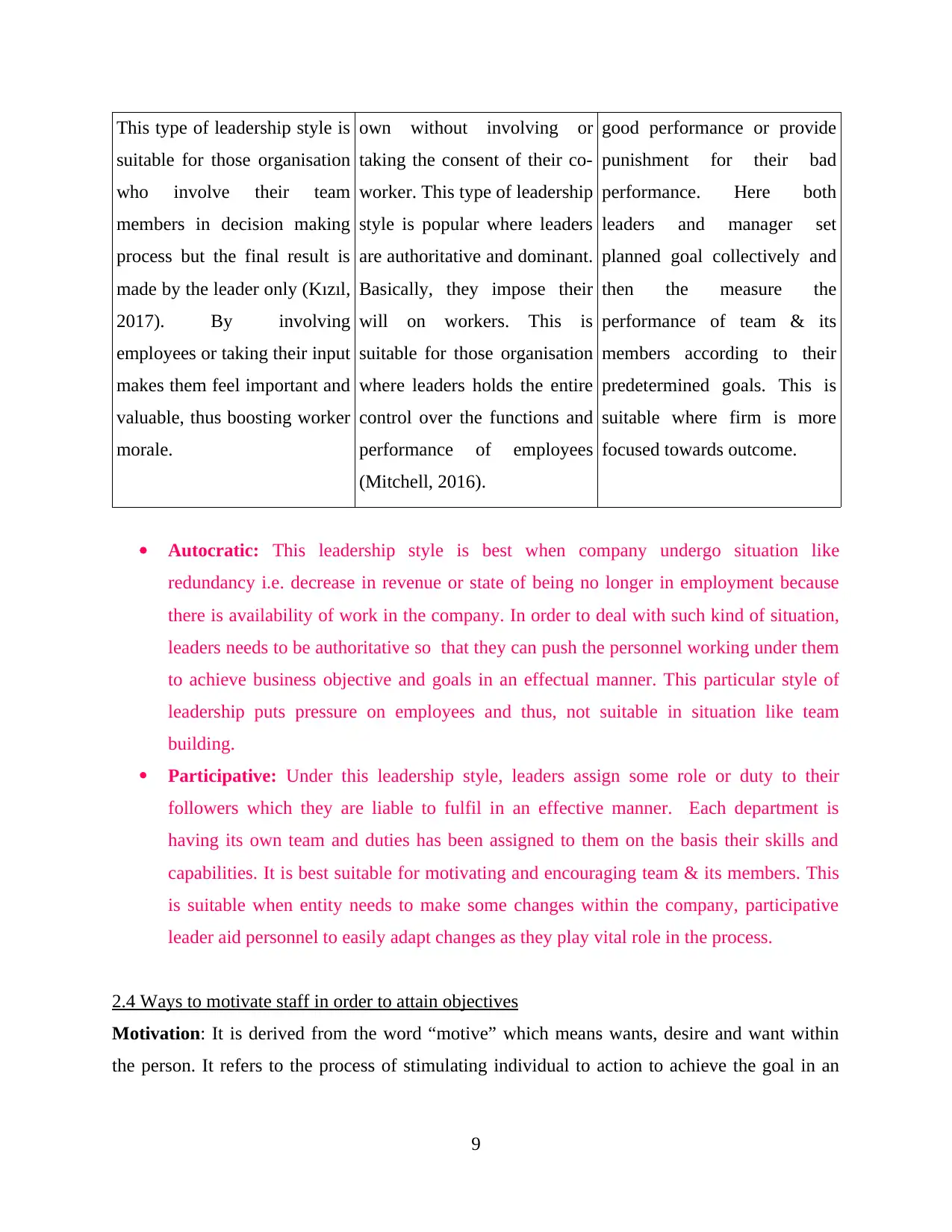
This type of leadership style is
suitable for those organisation
who involve their team
members in decision making
process but the final result is
made by the leader only (Kızıl,
2017). By involving
employees or taking their input
makes them feel important and
valuable, thus boosting worker
morale.
own without involving or
taking the consent of their co-
worker. This type of leadership
style is popular where leaders
are authoritative and dominant.
Basically, they impose their
will on workers. This is
suitable for those organisation
where leaders holds the entire
control over the functions and
performance of employees
(Mitchell, 2016).
good performance or provide
punishment for their bad
performance. Here both
leaders and manager set
planned goal collectively and
then the measure the
performance of team & its
members according to their
predetermined goals. This is
suitable where firm is more
focused towards outcome.
Autocratic: This leadership style is best when company undergo situation like
redundancy i.e. decrease in revenue or state of being no longer in employment because
there is availability of work in the company. In order to deal with such kind of situation,
leaders needs to be authoritative so that they can push the personnel working under them
to achieve business objective and goals in an effectual manner. This particular style of
leadership puts pressure on employees and thus, not suitable in situation like team
building.
Participative: Under this leadership style, leaders assign some role or duty to their
followers which they are liable to fulfil in an effective manner. Each department is
having its own team and duties has been assigned to them on the basis their skills and
capabilities. It is best suitable for motivating and encouraging team & its members. This
is suitable when entity needs to make some changes within the company, participative
leader aid personnel to easily adapt changes as they play vital role in the process.
2.4 Ways to motivate staff in order to attain objectives
Motivation: It is derived from the word “motive” which means wants, desire and want within
the person. It refers to the process of stimulating individual to action to achieve the goal in an
9
suitable for those organisation
who involve their team
members in decision making
process but the final result is
made by the leader only (Kızıl,
2017). By involving
employees or taking their input
makes them feel important and
valuable, thus boosting worker
morale.
own without involving or
taking the consent of their co-
worker. This type of leadership
style is popular where leaders
are authoritative and dominant.
Basically, they impose their
will on workers. This is
suitable for those organisation
where leaders holds the entire
control over the functions and
performance of employees
(Mitchell, 2016).
good performance or provide
punishment for their bad
performance. Here both
leaders and manager set
planned goal collectively and
then the measure the
performance of team & its
members according to their
predetermined goals. This is
suitable where firm is more
focused towards outcome.
Autocratic: This leadership style is best when company undergo situation like
redundancy i.e. decrease in revenue or state of being no longer in employment because
there is availability of work in the company. In order to deal with such kind of situation,
leaders needs to be authoritative so that they can push the personnel working under them
to achieve business objective and goals in an effectual manner. This particular style of
leadership puts pressure on employees and thus, not suitable in situation like team
building.
Participative: Under this leadership style, leaders assign some role or duty to their
followers which they are liable to fulfil in an effective manner. Each department is
having its own team and duties has been assigned to them on the basis their skills and
capabilities. It is best suitable for motivating and encouraging team & its members. This
is suitable when entity needs to make some changes within the company, participative
leader aid personnel to easily adapt changes as they play vital role in the process.
2.4 Ways to motivate staff in order to attain objectives
Motivation: It is derived from the word “motive” which means wants, desire and want within
the person. It refers to the process of stimulating individual to action to achieve the goal in an
9
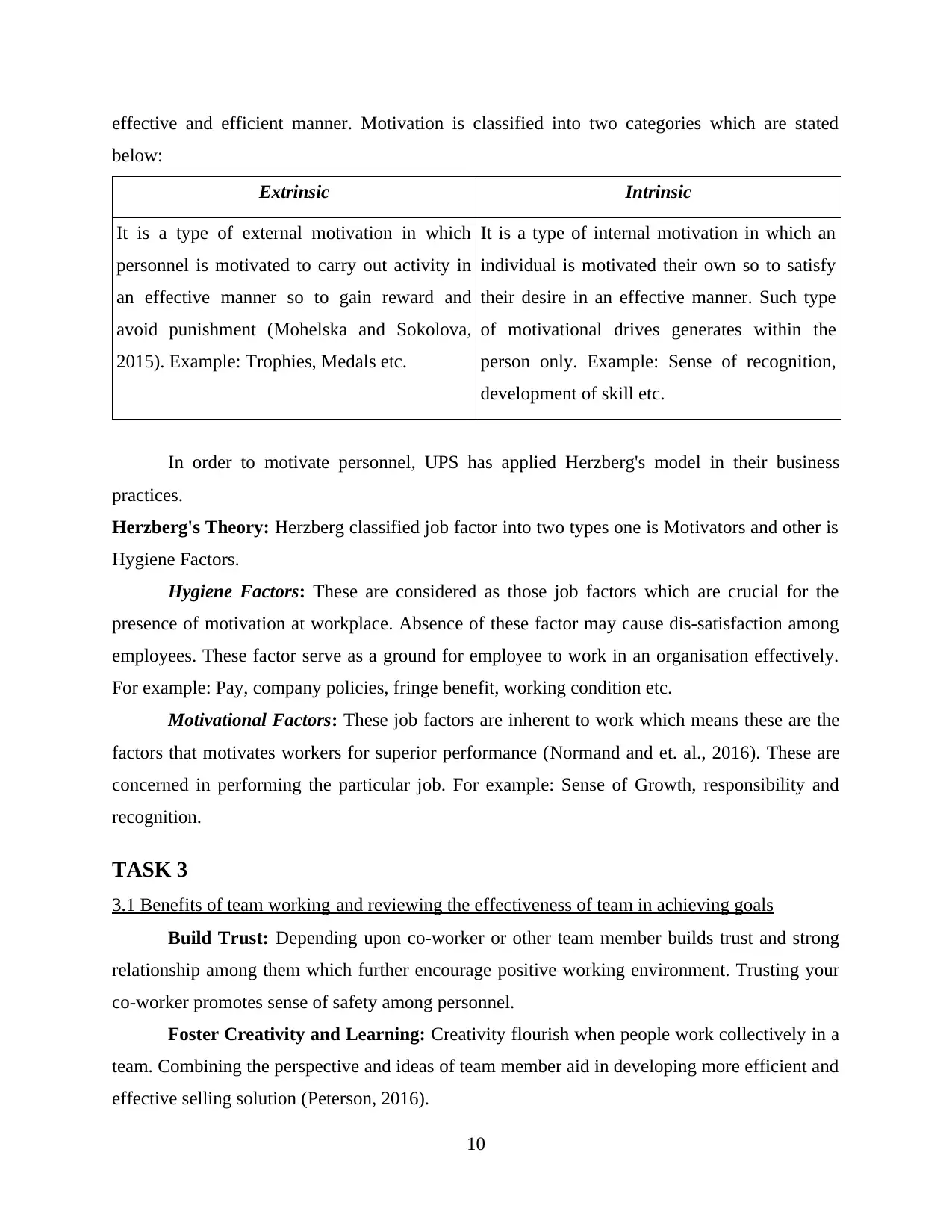
effective and efficient manner. Motivation is classified into two categories which are stated
below:
Extrinsic Intrinsic
It is a type of external motivation in which
personnel is motivated to carry out activity in
an effective manner so to gain reward and
avoid punishment (Mohelska and Sokolova,
2015). Example: Trophies, Medals etc.
It is a type of internal motivation in which an
individual is motivated their own so to satisfy
their desire in an effective manner. Such type
of motivational drives generates within the
person only. Example: Sense of recognition,
development of skill etc.
In order to motivate personnel, UPS has applied Herzberg's model in their business
practices.
Herzberg's Theory: Herzberg classified job factor into two types one is Motivators and other is
Hygiene Factors.
Hygiene Factors: These are considered as those job factors which are crucial for the
presence of motivation at workplace. Absence of these factor may cause dis-satisfaction among
employees. These factor serve as a ground for employee to work in an organisation effectively.
For example: Pay, company policies, fringe benefit, working condition etc.
Motivational Factors: These job factors are inherent to work which means these are the
factors that motivates workers for superior performance (Normand and et. al., 2016). These are
concerned in performing the particular job. For example: Sense of Growth, responsibility and
recognition.
TASK 3
3.1 Benefits of team working and reviewing the effectiveness of team in achieving goals
Build Trust: Depending upon co-worker or other team member builds trust and strong
relationship among them which further encourage positive working environment. Trusting your
co-worker promotes sense of safety among personnel.
Foster Creativity and Learning: Creativity flourish when people work collectively in a
team. Combining the perspective and ideas of team member aid in developing more efficient and
effective selling solution (Peterson, 2016).
10
below:
Extrinsic Intrinsic
It is a type of external motivation in which
personnel is motivated to carry out activity in
an effective manner so to gain reward and
avoid punishment (Mohelska and Sokolova,
2015). Example: Trophies, Medals etc.
It is a type of internal motivation in which an
individual is motivated their own so to satisfy
their desire in an effective manner. Such type
of motivational drives generates within the
person only. Example: Sense of recognition,
development of skill etc.
In order to motivate personnel, UPS has applied Herzberg's model in their business
practices.
Herzberg's Theory: Herzberg classified job factor into two types one is Motivators and other is
Hygiene Factors.
Hygiene Factors: These are considered as those job factors which are crucial for the
presence of motivation at workplace. Absence of these factor may cause dis-satisfaction among
employees. These factor serve as a ground for employee to work in an organisation effectively.
For example: Pay, company policies, fringe benefit, working condition etc.
Motivational Factors: These job factors are inherent to work which means these are the
factors that motivates workers for superior performance (Normand and et. al., 2016). These are
concerned in performing the particular job. For example: Sense of Growth, responsibility and
recognition.
TASK 3
3.1 Benefits of team working and reviewing the effectiveness of team in achieving goals
Build Trust: Depending upon co-worker or other team member builds trust and strong
relationship among them which further encourage positive working environment. Trusting your
co-worker promotes sense of safety among personnel.
Foster Creativity and Learning: Creativity flourish when people work collectively in a
team. Combining the perspective and ideas of team member aid in developing more efficient and
effective selling solution (Peterson, 2016).
10
⊘ This is a preview!⊘
Do you want full access?
Subscribe today to unlock all pages.

Trusted by 1+ million students worldwide
1 out of 17
Related Documents
Your All-in-One AI-Powered Toolkit for Academic Success.
+13062052269
info@desklib.com
Available 24*7 on WhatsApp / Email
![[object Object]](/_next/static/media/star-bottom.7253800d.svg)
Unlock your academic potential
Copyright © 2020–2025 A2Z Services. All Rights Reserved. Developed and managed by ZUCOL.





